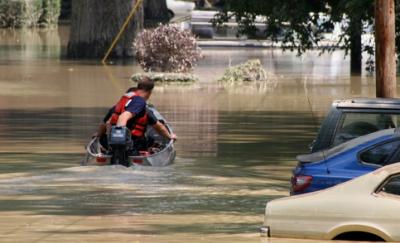How Climate Change Aggravates the Behavioral Health Pandemic—and What To Do About It



As torrential floodwaters burst through a broken levee in Pajaro, CA, there was no way to protect the farming community from inundation. "We have worked more than 40 years to achieve all this, and in 24 hours or less, everything we made over a lifetime is gone," 72-year-old Antonio Huezo told The Washington Post as he looked over the destruction.
Floods. A ruinous wildfire in Maui. An unusual hurricane in Southern California. The full spectrum of severe weather, made worse by climate change, has a devastating economic impact—matched by the psychological effects. The combination of those effects and the damage the COVID-19 pandemic inflicted—illness, death, forced isolation, job loss—has spawned a behavioral health pandemic. While life on the surface seems to be getting back to pre-COVID normal, the psychological scars remain. And the steady stream of devastating environmental events, which lead to population displacement, the breakdown of community infrastructure, and food and water scarcity, will prolong the recovery for many.
The behavioral health consequences of climate change range from eco-anxiety (a chronic fear of environmental doom) and emotional stress to clinical diagnoses, including depression and post-traumatic stress disorder. High risk coping behavior, such as substance misuse, has been associated with extreme weather events. While the Federal Emergency Management Agency (FEMA) can help rescue people and rebuild homes and offices, helping people with the array of behavioral health issues after FEMA leaves remains a challenge.
The distress of extreme weather events is particularly burdensome for certain populations: communities of color, Indigenous peoples, low-income families, LGBTQAI+, immigrants, people with disabilities, rural communities, the unstably housed, and agricultural communities. They often lack the resources to pay for or access to behavioral health services. These communities warrant special consideration for climate change preparedness and response.


Substantial evidence supports the notion that climate change affects behavioral health. A study last year in JAMA Psychiatry of 3.5 million emergency department visits found that compared with optimal temperature days, the hottest days have an eight percent higher incidence of visits for behavioral health issues, including anxiety, substance use disorder, self-harm, and symptoms experienced by people with schizophrenia.
Similarly, a 2018 study in PNAS linked meteorological data with a decade of behavioral health data for nearly two million U.S. residents. It showed that:
- hotter temperatures and added precipitation each increase anxiety, stress-related, and mood disorders
- multiyear warming is associated with an increased prevalence of behavioral health issues
- exposure to tropical cyclones, likely to increase in frequency and intensity in the future, is linked to worsened behavioral health.
The study concluded: "These results provide added large-scale evidence to the growing literature linking climate change and mental health."
One key to addressing the behavioral health effects of climate change is knowledge. What, exactly, is going on in a community? What are the environmental risks? Abt has developed a variety of tools to inform governments and the public about the impact of environmental change.
- Massachusetts’ Cumulative Impact Analysis (CIA). When a company applies for an emission permit, the CIA considers the interaction of the new source with existing nearby sources to calculate the cumulative impact.
- Search tool for the EPA’s Toxics Release Inventory homepage. The user-friendly, multi-lingual tool enables the public to learn about toxic releases in their communities and the risk and potential health impact.
- Risk-Screening Environmental Indicators. Developed for the EPA, the model assigns numerical scores to toxic releases based on the potential risk to human health.
- National Flood Risk Characterization Tool. The tool estimates the risk of flood (the most common natural disaster in the U.S.), captures the number of people at risk by key characteristics such as income level, and assesses the potential for asset damage, human exposure, and vulnerability metrics.
- COBRA Health Impacts Screening and Mapping Tool. The tool for the EPA enables users to estimate and map the monetized health benefits from reductions in fine particulate matter emissions.
- PFAS exposure tool. This online tool estimates personal exposure to four per- and polyfluoroalkyl substances (PFAS) with no blood sample required.


The evidence that a community and individuals can gather about health risks due to climate change can reduce eco-anxiety if the environmental data show improvement. Conversely, if the environmental data prove troubling, this may initiate or increase eco-anxiety for some. Yet, this knowledge can spur mitigation activities, which also could reduce stress levels.
For mitigation efforts to work, the initiatives need to recognize that the environmental risks come on top of what’s known as allostatic load, the wear and tear on the body that accumulates with repeated exposure to chronic stress. In vulnerable communities, the stress can stem from factors such as violence, poverty, and poor health and can have physiological consequences, such as coronary heart disease. Climate change, with intense heat in packed urban areas and particulates in the air from wildfires can worsen these conditions.
As a result, mitigation initiatives must bridge public health, behavioral health, and environmental efforts and harness lessons learned from the field of environmental justice. We need to get better at these collaborative efforts, for the behavioral health pandemic remains virulent, stemming in part from climate change, even as we move into a more normal post-COVID-19 pandemic world.
Indeed, it’s impossible to overstate the psychological impact on Antonio Huezo as he watched a flood destroy his life’s work. It may be fitting that the name of his town, Pajaro, means bird in Spanish. It may be the canary in the coal mine. Just as ignoring dead canaries in mines would be foolhardy, we ignore the fate of Pajaro and the depressing effects on its residents at our peril.
Read more

The 29th Conference of the Parties to the United Nations Framework Convention on Climate Change (COP29)
Abt will join governments, the private sector, and civil society at the 29th Conference of the Parties to the United Nations Framework Convention on Climate Change (COP29) this November to accelerate climate action.

Spotlight On: Climate Finance
Abt Global can help public-and private-sector actors take decisive action to finance equitable climate mitigation and adaptation strategies.

Nature Can Be a Solution to Climate Adaptation
Several years ago, my family took in a young man and his elderly mother after a flood destroyed their home. Eleven inches of rain had fallen in two days on tiny Painesville, Ohio, a community of 20,000 not far from Lake Erie. The Grand River had swollen to nine times its size and spilled into a row of low-income condominiums. Floodwater pushed past first-floor ceilings, in some cases rising to 17 feet.

Sixteenth Meeting of the Conference of the Parties to the Convention of Biological Diversity (COP16)